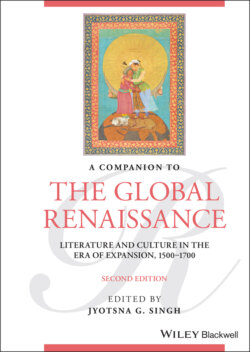Читать книгу A Companion to the Global Renaissance - Группа авторов - Страница 17
III Chapter Summaries
ОглавлениеThe title of this anthology, The Global Renaissance, not only calls for a reconsideration of the scope and meaning of the term “Renaissance” as I have discussed. It also encourages us to “think globally” at the intersections of contemporary global capitalism and its cultural networks and the early modern flow and exchange of commodities, persons, ideas, technologies, and aesthetic objects in relation to emergent colonialism involving England and Europe. Such an epistemology helps us to confront globalization today, which many consider the central crisis of our times. Immanuel Wallerstein historicizes the “discourse of globalization” in similar terms when he states: “we are told by virtually everyone that we are now living, and for the first time, in an era of globalization … [but] the processes that are usually meant when we speak of globalization are not in fact new at all. They have existed for some 500 years” (249). Wallerstein’s historical formulation of a global system is a useful way of understanding the systemic nature of globalization through different periods. And many of the themes and issues within the essays in this collection resonate with contemporary concerns, including flows of capital and labor power, rampant consumerism and material culture, race and gender struggles within the new global cultural economy, and East–West economic power struggles and relations with Islam. While it is important to observe anticipations and echoes between the two different historical moments, and especially in terms of the emergence of capitalism and its links with colonialism, as Wallerstein suggests, it is also necessary, following Foucault’s reading of history, to avoid a “totalization of past and present” (Poster, 76). As a result, by disrupting any sense of a seamless continuity between the global drives in the different periods we can retrospectively question the inevitability of supposedly inexorable forces of globalization, which are sometimes evoked in terms of a stereotypical “march of history.”11
The broad range of essays in this volume offers us a rich, pluralistic perspective on the early modern global world. One way of understanding the ways in which early modern discourses and practices of globalization may conform to or diverge from contemporary global trends and events is via a broad power–knowledge axis: approaching any economic or cultural process as a multiplicity in order to explore each discourse or practice separately, unpacking its layers, decoding its meanings, and understanding its development both in its own terms and in relation to larger, cumulative effects of change.12 This collection of 29 chapters and one Afterword engages with the “global” precisely thus: as a multiplicity, encompassing the intersections of global and domestic discourses and practices; in some instances, evoking our contemporary global crises; reminding us that the processes of exploration, travel, trade, cross-cultural and religious interactions, and labor exploitation, among others, have continuing relevance today. And finally, and perhaps crucially, we learn that globalization is not simply an economic or political movement, but equally, as the essays reveal, a product of the ideological work done by literature, art and visual culture, travel writing, legal treatises, ethnographic inquiries, and other cultural texts.
The chapters of The Global Renaissance are organized into four parts: Mapping the Global, “Contact Zones,” “To Live by Traffic”: Global Networks of Exchange, and The Globe Staged. These titles do not imply rigid divisions but rather denote some broad categorizations within which all the chapters share common themes and concerns. The essays in this first section all engage with globalization and the global in terms of larger historical and conceptual paradigms.
